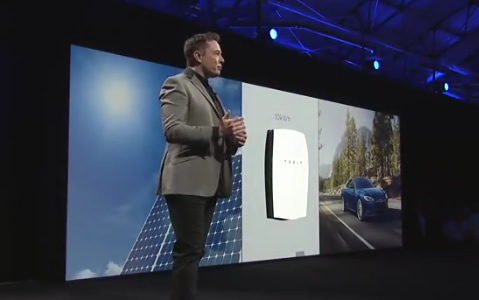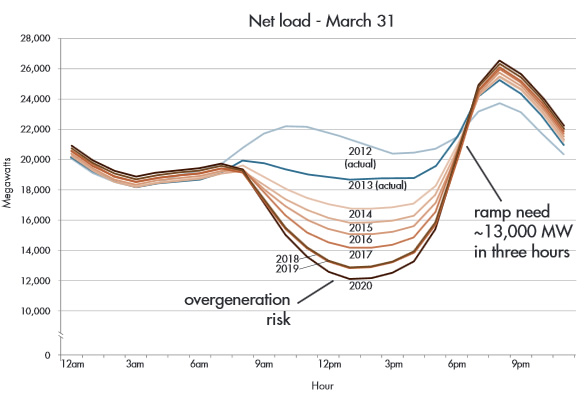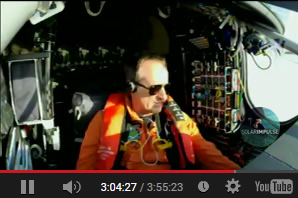Welcome to the
Run on Sun Monthly Newsletter

In this Issue: |
May, 2015
Volume: 6 Issue: 5
Elon Musk's 3-Biggest Powerwall WhoppersElon Musk is a visionary and a showman, but occasionally his enthusiasm for his vision gets way out ahead of reality. Nowhere was that disconnect more on display than this past week when he made his much talked about announcement of the Tesla Powerwall battery storage system. While we share the vision for the potential of battery systems (such as the one Enphase Energy is set to release later this year, albeit in a far more understated fashion), when 38,000 people go online to order a product that doesn't yet exist, it is time to debunk some of the more exorbitant claims made by Musk. Here are the three biggest whoppers that Musk made during his Powerwall presentation (link to video below). 
Whopper #3 - Power for an ice storm or other significant grid failure eventMusk touted the "peace of mind" that would come from having the Powerwall, and said, "if there's a cut in the utilities you're always gonna have power, particularly if you're in a place that's very cold, now you don't have to worry about being out of power if there's an ice storm." (See video at 8:35.) The Powerwall unit that Musk was talking about that was designed for "daily cycling" was a 7 kWh unit that is priced at $3,000. The average home in the Run on Sun service area uses 25 kWh/day. So a single Powerwall unit provides roughly one quarter of the energy demand of an average home. If your desire for "peace of mind" means running your home for a full day in normal fashion, you will need to purchase 4 Powerwall units (assuming you have the wall space to mount them) and that will cost you $12,000. Of course, many outages last longer than a day. The longer you want to stay powered, the more units you will need. Whopper #2 - Powerwall will work with existing solar systemsMusk insisted that Powerwall has been designed to work with solar systems, "right out of the box." (See video at 8:25.) Except... that the Powerwall is designed to fit between existing solar panels and the DC-AC inverter(s) in the system (i.e., on the DC side of the system). But here's the thing - the vast majority of inverters are what are known as "grid-tied," which means if the grid goes down, the inverter shuts off, and stays off until the grid comes back. If the Powerwall is on the DC side, there is no way for it to "mimic" the grid (which, of course, is on the AC side), and so the inverter will shut off. While the inverter could certainly be replaced with a hybrid inverter (that can work both independently and tied to the grid) such a replacement is a pricey undertaking and certainly not a plug-and-play installation. But Musk, like the true showman that he is, saved his biggest Whopper for the end... Whopper #1 - You can go off grid... for $3,500!Warming to his subject, Musk really brought down the house with his most outrageous claim of all:
No. No you cannot. Let's unpack his statement. There's two major claims here, neither of which is true. The first is that you could go completely off-grid, and the second is that it would cost you $3,500. So let's start with the easy one to disprove, indeed, we already did above: this won't cost $3,500. The Powerwall provides 7 kWh of storage. The average house uses 25 kWh/day. If the battery has to run your house for just one day, you would need 4 Powerwall units at a cost of $12,000. (The 7 kWh unit is the one designed for daily cycling - what you need to go off-grid, and it costs $3,000 - if you could actually purchase one, which you can't.) So that's easy to debunk. But what about the second, more fundamental question. Can I use this Powerwall system to go off-grid without changing my middle-class, suburban lifestyle? For most folks the answer is simply, no. Here's why. When you go off-grid you need to be able to meet all of your energy needs all the time without assistance from your local utility. To do that, you need a battery system large enough to last you during the longest typical shortfall of available energy (i.e., how many stormy/cloudy days in a row will you see), plus a solar array large enough to charge that battery on sunny days while meeting the household needs. Turns out, that is quite a lot of both. Folks who design off-grid systems (very few of which are found in areas like Pasadena), typically design for three (or more) days of self-sufficiency (or autonomy, as they put it). For our typical, 25 kWh/day home, that would require storage of a minimum of 75 kWh. But according to Tesla, you can only stack a maximum of nine Powerwall units, which limits you to 63 kWh. Sometime around noon on that third day without sun, your house will shut down. Oh, and that much storage will cost you $27,000. What about the solar array side of the equation? Let's start by asking how big an array can you fit on an average house? House sizes have trended bigger in the past couple of decades, so more recently built houses are an overstatement of the average house out there. Still, to have a starting point (and to give Musk the benefit of the doubt), let's assume that our average house is 2,400 square feet (a fair estimate based on US Census data), and that it is optimally designed to maximize solar production: a near perfect square with a true south face, pitched at latitude (34° here in Pasadena), with no shading. Of course, we still have to give the Fire Marshall the desired setoffs so that gets us to 1,115 square feet of roof space (math available upon request), enough for 62 LG 305 solar modules, but because we need to use a hybrid inverter with fixed string sizes, we will drop that down to 60 solar modules. That yields an 18.3 kW system which at $3.50/Watt would cost a cool $64,000 - and be bigger than our biggest ever residential installation. So the Sixty-four Thousand Dollar question becomes: How well will that do on meeting our needs? Per the CSI calculator, this maximal system will produce roughly 29,000 kWh in Year 1, or an average daily output of 79.5 kWh. (Less in the winter, of course, when you are most likely to see those cloudy days.) After providing for my daily needs of 25 kWh, I have 54.5 kWh to spare, not quite enough to fully charge my batteries (which require 63 kWh). A scenario where I have two cloudy days, followed by one partly sunny day, followed by two more cloudy days could easily leave you in the lurch. And for this you paid a total of $91,000! If you live somewhere with poorer weather than what we find in the Run on Sun service area (i.e., pretty much the entire rest of the country!) your performance will be even more dismal. The true value of storageThe sad part of this whole thing is that battery storage combined with solar is going to be huge, but not for the reasons Musk alluded to in his speech. The future of utility rates is the shift to time-of-use rate structures - a fact already well and painfully known by our clients in SCE territory, and soon to be seen by everyone. Time-of-use rates, where utility customers pay more for energy during the peak part of the day, are the only way to match utility costs with customer charges. (It is the head of the Duck in the famous Duck Curve below.)
That "overgeneration" that drives down demand at noon is presently fed back to the grid, where the grid operator has to modify the power mix to accommodate it - in essence, it is wasted. (Although presently, net metering customers get full retail credit for it - something, that in all likelihood, will soon go away.) But add storage to the mix, and you shift that overgeneration from the middle of the day, to the evening peak hours, benefiting the time-of-use customer as well as the utility. It is the way to bring about a peaceful end to the utility-solar wars, and it is the true benefit of storage to solar customers - without oversizing either your solar array or your storage system. So let's all get excited over solar with storage, but for the right, and much more cost-effective reasons - and not the nonsensical hype being spewed by that super showman, Elon Musk. |
“But Musk, like the true showman that he is, saved his biggest Whopper for the end…”
Get your copy of
Commercial Solar:
Step-by-Step
from
Run on Sun
Founder & CEO
Jim Jenal

Now available on Amazon.com
in both
Print & Kindle versions.
Bonus - Buy the Print version…
Get the
Kindle version for Free!
Commercial Solar:
Step-by-Step
from Run on Sun
Founder & CEO
Jim Jenal

Now available on Amazon.com
in both Print & Kindle versions.
Get the Kindle version for Free!
It's so On! SI2 Launches on 6-day Flight to HawaiiSolar Impulse 2 - the entirely solar-powered airplane that is attempting to fly around the world - just took off on the most audacious leg of its amazingly audacious mission: to fly non-stop from Nanjing China to Hawaii. This is a non-trivial flight in a conventional jetliner, one from which many passengers will disembark complaining of cramped quarters and a lack of sleep. But the pilot of SI2, Andre Borschberg, will need to stay awake (mostly) for six days in a cabin slightly smaller than Dr. Who's TARDIS Police Box!
Rest for the weary pilot comes in 20 minute breaks, ended by a gentle alarm if all is well, or a more insistent alert if something has gone awry. To maintain physical and mental health, the pilot practices both yoga and self-hypnosis, as well as a limited set of exercises that can be performed within the cabin's confines. You can learn more about the background of this mission, and even monitor how solar energy is powering the flight at the Solar Impulse website. |


